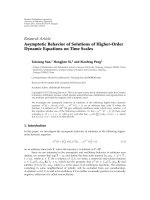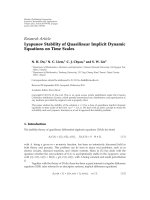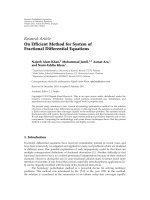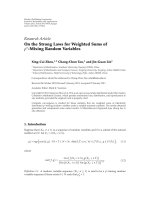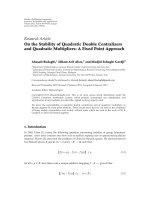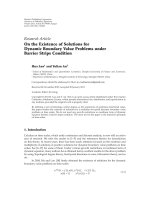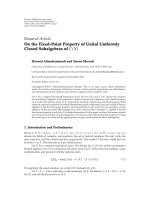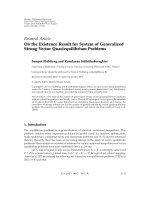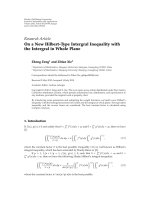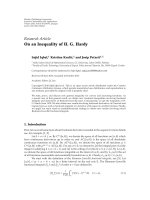Báo cáo hoa học: " Research Article On Boundedness of Solutions of the Difference Equation xn 1 pxn qxn−1 / 1 xn for q 1 p 1" pot
Bạn đang xem bản rút gọn của tài liệu. Xem và tải ngay bản đầy đủ của tài liệu tại đây (500.17 KB, 11 trang )
Hindawi Publishing Corporation
Advances in Difference Equations
Volume 2009, Article ID 463169, 11 pages
doi:10.1155/2009/463169
Research Article
On Boundedness of Solutions of the Difference
Equation x
n1
px
n
qx
n−1
/1 x
n
for q>1 p>1
Hongjian Xi,
1, 2
Taixiang Sun,
1
Weiyong Yu,
1
and Jinfeng Zhao
1
1
Department of Mathematics, Guangxi University, Nanning, Guangxi 530004, China
2
Department of Mathematics, Guangxi College of Finance and Economics,
Nanning, Guangxi 530003, China
Correspondence should be addressed to Taixiang Sun,
Received 4 February 2009; Revised 19 April 2009; Accepted 2 June 2009
Recommended by Agacik Zafer
We study the boundedness of the difference equation x
n1
px
n
qx
n−1
/1 x
n
, n 0, 1, ,
where q>1 p>1 and the initial values x
−1
,x
0
∈ 0, ∞. We show that the solution {x
n
}
∞
n−1
of
this equation converges to
x q p − 1ifx
n
≥ x or x
n
≤ x for all n ≥−1; otherwise {x
n
}
∞
n−1
is
unbounded. Besides, we obtain the set of all initial values x
−1
,x
0
∈ 0, ∞×0, ∞ such that the
positive solutions {x
n
}
∞
n−1
of this equation are bounded, which answers the open problem 6.10.12
proposed by Kulenovi
´
c and Ladas 2002 .
Copyright q 2009 Hongjian Xi et al. This is an open access article distributed under the Creative
Commons Attribution License, which permits unrestricted use, distribution, and reproduction in
any medium, provided the original work is properly cited.
1. Introduction
In this paper, we study the following difference equation:
x
n1
px
n
qx
n−1
1 x
n
,n 0, 1, , 1.1
where p, q ∈ 0, ∞ with q>1 p and the initial values x
−1
,x
0
∈ 0, ∞.
The global behavior of 1.1 for the case p q<1 is certainly folklore. It can be found,
for example, in 1see also a precise result in 2.
The global stability of 1.1 for the case pq 1 follows from the main result in 3see
also Lemma 1 in Stevi
´
c’s paper 4. Some generalizations of Copson’s result can be found,
for example, in papers 5–8. Some more sophisticated results, such as finding the asymptotic
behavior of solutions of 1.1 for the case p q 1 even when p 0 can be found, for
2 Advances in Difference Equations
example, in papers 4see also 8–11. Some other properties of 1.1 have been also treated
in 4.
The case q 1p was treated for the first time by Stevi
´
c’s in paper 12. The main trick
from 12 has been later used with a success for many times; see, for example, 13–15.
Some existing results for 1.1 are summarized as follows16.
Theorem A. 1 If p q ≤ 1, then the zero equilibrium of 1.1 is globally asymptotically stable.
2 If q 1, then the equilibrium
x p of 1.1 is globally asymptotically stable.
3 If 1 <q<1 p, then every positive solution of 1.1 converges to the positive equilibrium
x p q − 1.
4 If q 1 p, then every positive solution of 1.1 converges to a period-two solution.
5 If q>1 p,then1.1 has unbounded solutions.
In 16, Kulenovi
´
c and Ladas proposed the following open problem.
Open problem B (see Open problem 6.10.12of [16])
Assume that q ∈ 1, ∞.
a Find the set B of all initial conditions x
−1
,x
0
∈ 0, ∞ × 0, ∞ such that the
solutions {x
n
}
∞
n−1
of 1.1 are bounded.
b Let x
−1
,x
0
∈ B. Investigate the asymptotic behavior of {x
n
}
∞
n−1
.
In this paper, we will obtain the following results: let p, q ∈ 0, ∞ with q>1 p,and
let {x
n
}
∞
n−1
be a positive solution of 1.1 with the initial values x
−1
,x
0
∈ 0, ∞ × 0, ∞.
If x
n
≥ x for all n ≥−1 or x
n
≤ x for all n ≥−1, then {x
n
}
∞
n−1
converges to x q p − 1.
Otherwise {x
n
}
∞
n−1
is unbounded.
For closely related results see 17–34.
2. Some Definitions and Lemmas
In this section, let q>1 p>1andx q p − 1 be the positive equilibrium of 1.1.Write
D 0, ∞ × 0, ∞ and define f : D → D by, for all x, y ∈ D,
f
x, y
y,
py qx
1 y
. 2.1
It is easy to see that if {x
n
}
∞
n−1
is a solution of 1.1, then f
n
x
−1
,x
0
x
n−1
,x
n
for any n ≥ 0.
Let
A
1
0, x
×
0, x
,A
2
x, ∞
×
x, ∞
,
A
3
0, x
×
x, ∞
,A
4
x, ∞
×
0, x
,
R
0
{
x
}
×
0, x
,L
0
{
x
}
×
x, ∞
,
R
1
0, x
×
{
x
}
,L
1
x, ∞
×
{
x
}
.
2.2
Advances in Difference Equations 3
Then D ∪
4
i1
A
i
∪ L
0
∪ L
1
∪ R
0
∪ R
1
∪{x, x}. T he proof of Lemma 2.1 is quite similar to
that of Lemma 1 in 35 and hence is omitted.
Lemma 2.1. The following statements are true.
1 f : D → fD is a homeomorphism.
2 fL
1
L
0
and fL
0
⊂ A
4
.
3 fR
1
{x}×p, x and fR
0
⊂ A
3
.
4 fA
3
⊂ A
4
and fA
4
⊂ A
3
.
5 A
2
∪ L
1
⊂ fA
2
⊂ A
2
∪ L
1
∪ A
4
and A
1
∪ R
1
⊂ fA
1
⊂ A
1
∪ R
1
∪ A
3
.
Lemma 2.2. Let q>1 p>1, and let {x
n
}
∞
n−1
be a positive solution of 1.1.
1 If lim
n → ∞
x
2n
a ∈ 0, ∞ and a
/
p,thenlim
n → ∞
x
2n1
a x.
2 If lim
n → ∞
x
2n−1
b ∈ 0, ∞ and b
/
p,thenlim
n → ∞
x
2n
b x.
Proof. We show only 1 because the proof of 2 follows from 1 by using the change y
n
x
n−1
and the fact that 1 is autonomous. Since lim
n → ∞
x
2n
a ∈ 0, ∞ and a
/
p,by1.1
we have
lim
n → ∞
x
2n1
lim
n → ∞
qx
2n
− x
2n2
x
2n2
− p
q − 1
a
a − p
. 2.3
Also it follows from 1.1 that
a lim
n → ∞
x
2n
lim
n → ∞
qx
2n−1
− x
2n1
x
2n1
− p
q − 1
2
a
q − 1
a − p
a − p
, 2.4
from which we have a
x and lim
n → ∞
x
2n1
a x. This completes the proof.
Lemma 2.3. Let q>1 p>1, and let {x
n
}
∞
n−1
be a positive solution of 1.1 with the initial values
x
−1
,x
0
∈ A
4
.Ifthereexistssomen ≥ 0 such that x
2n−1
≥ x
2n1
,thenx
2n
≥ x
2n2
.
Proof. Since x
−1
,x
0
∈ A
4
, it follows from Lemma 2.1 that x
2n−1
,x
2n
∈ A
4
for any n ≥ 0.
Without loss of generality we may assume that n 0, that is, x
−1
≥ x
1
. Now we show x
0
≥ x
2
.
Suppose for the sake of contradiction that x
0
<x
2
, then
x
−1
≥ x
1
px
0
qx
−1
1 x
0
, 2.5
x
0
<x
2
px
1
qx
0
1 x
1
.
2.6
By 2.5 we have
x
0
≥
x
−1
q − 1
x
−1
− p
, 2.7
4 Advances in Difference Equations
and by 2.6 we get
q − 1 − p
x
2
0
p
2
q − 1 − qx
−1
x
0
pqx
−1
> 0. 2.8
Claim 1. If x
−1
≥ x, then
p
2
q − 1 − qx
−1
2
− 4
q − 1 − p
pqx
−1
≥ 0. 2.9
Proof of Claim 1
Let gxp
2
q − 1 − qx
2
− 4q − 1 − ppqx x ≥ x, then we have
g
x
2q
1 qx − p
2
− q
− 4pq
q − 1 − p
≥ 2q
q − 1
2
p
2
p
1 − q
p
2q
q − 1
q − p − 1
p
2
p
> 0.
2.10
Since x
−1
≥ x, it follows
p
2
q − 1 − qx
−1
2
− 4
q − 1 − p
pqx
−1
≥
q
2
qp − 2q 1 − p
2
2
− 4
q − 1 − p
qp
q p − 1
q
2
− 2q 1 − p
2
2
2qp
q
2
− 2q 1 − p
2
qp
2
− 4
q
2
− 2q 1 − p
2
pq
q
2
− 2q 1 − p
2
− pq
2
≥ 0.
2.11
This completes the proof of Claim 1.
By 2.8, we have
x
0
>λ
1
1 qx
−1
− p
2
− q
1 qx
−1
− p
2
− q
2
− 4pq
q − 1 − p
x
−1
2
q − 1 − p
2.12
Advances in Difference Equations 5
or
x
0
<λ
2
1 qx
−1
− p
2
− q
−
1 qx
−1
− p
2
− q
2
− 4pq
q − 1 − p
x
−1
2
q − 1 − p
. 2.13
Claim 2. We have
λ
1
≥ x, 2.14
λ
2
≤
x
−1
q − 1
x
−1
− p
.
2.15
Proof of Claim 2
Since
1 qq p − 1 − p
2
− q
2
− 4pq
q − 1 − p
p q − 1
q
2
− p
2
− 2q 1 − qp
2
q p − 1
q − 1 − p
−
1 q
q p − 1
− p
2
− q
,
2.16
we have
λ
1
1 qx
−1
− p
2
− q
1 qx
−1
− p
2
− q
2
− 4pq
q − 1 − p
x
−1
2
q − 1 − p
≥
1 q
x − p
2
− q
1 q
x − p
2
− q
2
− 4pq
q − 1 − p
x
2
q − 1 − p
1 q
q p − 1
− p
2
− q
1 qq p − 1 − p
2
− q
2
− 4pq
q − 1 − p
p q − 1
2
q − 1 − p
≥
q p − 1
x.
2.17
The proof of 2.14 is completed.
Now we show 2.15.Let
h
x
pq
x − p
2
−
x − p
q − 1
1 qx − p
2
− q
q − 1
2
q − 1 − p
x. 2.18
6 Advances in Difference Equations
Note that 2pq − 2qq − 1 < 0; it follows that if x ≥
x, then
h
x
2pq
x − p
−
q − 1
1 qx − p
2
− q
q
q − 1
x − p
−
q − 1
2
q − 1 − p
≤ 2pq
q − 1
−
q − 1
2pq − q − p
2
q
2
− p
q − 1
q p
p 1 − q
< 0,
2.19
which implies that hx is decreasing for x ≥
x. Since x
−1
≥ x and
h
x
pq
q − 1
2
−
q − 1
q − 1
1 q
q p − 1
− p
2
− q
q − 1
2
q − 1 − p
q p − 1
0,
2.20
it follows that
h
x
−1
pq
x
−1
− p
2
−
x
−1
− p
q − 1
1 qx
−1
− p
2
− q
q − 1
2
q − 1 − p
x
−1
≤ h
x
0.
2.21
Thus
q − 1
2
1 qx
−1
− p
2
− q
2
− 4pq
q − 1 − p
x
−1
≥ 4p
2
q
2
x
−1
− p
2
− 4pq
x
−1
− p
q − 1
1 qx
−1
− p
2
− q
q − 1
2
1 qx
−1
− p
2
− q
2
.
2.22
This implies that
q − 1
1 qx
−1
− p
2
− q
2
− 4pq
q − 1 − p
x
−1
≥ 2pq
x
−1
− p
−
q − 1
1 qx
−1
− p
2
− q
.
2.23
Finally we have
x
−1
q − 1
x
−1
− p
≥
4
q − 1 − p
pqx
−1
2
q − 1 − p
1 qx
−1
− p
2
− q
1 qx
−1
− p
2
− q
2
− 4pq
q − 1 − p
x
−1
1 qx
−1
− p
2
− q
−
1 qx
−1
− p
2
− q
2
− 4pq
q − 1 − p
x
−1
2
q − 1 − p
λ
2
.
2.24
The proof of 2.15 is completed.
Advances in Difference Equations 7
Note that x
0
< x since x
−1
,x
0
∈ A
4
.By2.12, 2.13, 2.14,and2.15,weseex
0
<
x
−1
q − 1/x
−1
− p, which contradicts to 2.7. The proof of Lemma 2.3 is completed.
3. Main Results
In this section, we investigate the boundedness of solutions of 1.1.Letq>1 p>1, and
let {x
n
}
∞
n−1
be a positive solution of 1.1 with the initial values x
−1
,x
0
∈ 0, ∞ × 0, ∞,
then we see that x
n1
− xx
n
− x < 0 for some n ≥−1orx
n
≥ x for all n ≥−1orx
n
≤ x for
all n ≥−1.
Theorem 3.1. Let q>1 p>1, and let {x
n
}
∞
n−1
be a positive solution of 1.1 such that x
n
≥ x for
all n ≥−1 or x
n
≤ x for all n ≥−1,then{x
n
}
∞
n−1
converges to x q p − 1.
Proof.
Case 1. 0 <x
n
≤ x for any n ≥−1. If 0 <x
2n
≤ q − 1 for some n, then
x
2n1
− x
2n−1
px
2n
qx
2n−1
− x
2n−1
− x
2n−1
x
2n
1 x
2n
> 0. 3.1
If q − 1 <x
2n
≤ x for some n, then
px
2n
x
2n
− q 1
≥
p
x
x − q 1
x ≥ x
2n−1
, 3.2
which implies that px
2n
≥ x
2n−1
x
2n
− q 1 and
x
2n1
− x
2n−1
px
2n
qx
2n−1
− x
2n−1
− x
2n−1
x
2n
1 x
2n
≥ 0. 3.3
Thus
x ≥ x
2n1
≥ x
2n−1
for any n ≥ 0. In similar fashion, we can show x ≥ x
2n2
≥ x
2n
for any
n ≥ 0. Let lim
n → ∞
x
2n1
a and lim
n → ∞
x
2n
b, then
a
pb qa
1 b
,b
pa qb
1 a
, 3.4
which implies a b
x.
8 Advances in Difference Equations
Case 2. x
n
≥ x p q − 1 for any n ≥−1. Since fx, ypy qx/1 yx>p/q is
decreasing in y, it follows that for any n ≥−1,
x
n2
px
n1
qx
n
1 x
n1
≤
p
x qx
n
1 x
≤ x
n
.
3.5
In similar fashion, we can show that lim
n → ∞
x
2n1
lim
n → ∞
x
2n
x. This completes the
proof.
Lemma 3.2 see 20, Theorem 5. Let I be a set, and let F : I × I → I be a function Fu, v
which decreases in u and increases in v, then for every positive solution {x
n
}
∞
n−1
of equation x
n1
Fx
n
,x
n−1
, {x
2n
}
∞
n0
and {x
2n−1
}
∞
n0
do exactly one of the following.
1 They are both monotonically increasing.
2 They are both monotonically decreasing.
3 Eventually, one of them is monotonically increasing, and the other is monotonically
decreasing.
Remark 3.3. Using arguments similar to ones in the proof of Lemma 3.2,Stevi
´
c proved
Theorem 2 in 25. Beside this, this trick have been used by Stevi
´
cin18, 28, 29.
Theorem 3.4. Let q>1 p>1, and let {x
n
}
∞
n−1
be a positive solution of 1.1 such that x
n1
−
xx
n
− x < 0 for some n ≥−1,then{x
n
}
∞
n−1
is unbounded.
Proof. We may assume without loss of generality that x
0
− xx
−1
− x < 0andx
−1
,x
0
∈ A
4
the proof for x
−1
,x
0
∈ A
3
is similar.FromLemma 2.1 we see x
2n−1
,x
2n
∈ A
4
for all
n ≥ 0.If {x
2n
}
∞
n0
is eventually increasing, then it follows from Lemma 2.3 that {x
2n−1
}
∞
n0
is
eventually increasing. Thus lim
n → ∞
x
2n−1
b>x and lim
n → ∞
x
2n
a ≤ x, it follows from
Lemma 2.2 that b ∞.
If {x
2n
}
∞
n0
is not eventually increasing, then there exists some N ≥ 0 such that
x
2N
≥ x
2N2
px
2N1
qx
2N
1 x
2N1
, 3.6
from which we obtain x
2N
≥ px
2N1
/1 x
2N1
− q ≥ p,sincex
2N1
≥ x p q − 1andq>1.
Since fy,xpy qx/1 yp qx − p/1 yx ≥ p, y ≥ p is increasing
in x andisdecreasinginy, we have that x
2n
≥ p for any n ≥ N. It follows from Lemma 3.2
that {x
2n
}
∞
n0
is eventually decreasing. Thus lim
n → ∞
x
2n
a<x and lim
n → ∞
x
2n−1
b ≥ x.
It follows from Lemma 2.2 that b ∞. This completes the proof.
By Theorems 3.1 and 3.4 we have the following.
Corollary 3.5. Let q>1 p>1, and let {x
n
}
∞
n−1
be a positive bounded solution of 1.1,then
x
n−1
≥ x
n
≥ x for all n ≥ 0 or x ≥ x
n
≥ x
n−1
for all n ≥ 0.
Advances in Difference Equations 9
Now one can find out the set of all initial values x
−1
,x
0
∈ 0, ∞ × 0, ∞ such that
the positive solutions of 1.1 are bounded. Let P
0
A
2
,Q
0
A
1
. For any n ≥ 1, let
P
n
f
−1
P
n−1
,Q
n
f
−1
Q
n−1
. 3.7
It follows from Lemma 2.1 that P
1
f
−1
P
0
⊂ P
0
,Q
1
f
−1
Q
0
⊂ Q
0
, which implies
P
n
⊂ P
n−1
,Q
n
⊂ Q
n−1
3.8
for any n ≥ 1.
Let S be the set of all initial values x
−1
,x
0
∈ 0, ∞ × 0, ∞ such that the positive
solutions {x
n
}
∞
n−1
of 1.1 are bounded. Then we have the following theorem.
Theorem 3.6. S
∞
n0
Q
n
∪
∞
n0
P
n
⊂ A
1
∪ A
2
∪{x, x}.
Proof. Let {x
n
}
∞
n−1
be a positive solution of 1.1 with the initial values x
−1
,x
0
∈ S.
If x
−1
,x
0
∈
∞
n0
Q
n
, then f
n
x
−1
,x
0
x
n−1
,x
n
∈ A
1
for any n ≥ 0, which implies
x
n
≤ x for any n ≥−1. It follows from Theorem 3.1 that lim
n →∞
x
n
x.
If x
−1
,x
0
∈
∞
n0
P
n
, then f
n
x
−1
,x
0
x
n−1
,x
n
∈ A
2
, which implies x
n
≥ x for any
n ≥−1. It follows from Theorem 3.1 that lim
n →∞
x
n
x.
Now assume that {x
n
}
∞
n−1
is a positive solution of 1.1 with the initial values
x
−1
,x
0
∈ D − S.
If x
−1
,x
0
∈ A
3
A
4
L
0
L
1
R
0
R
1
, then it follows from Lemma 2.1 that
f
2
x
−1
,x
0
x
1
,x
2
∈{x, y : x − xy − x < 0}, which along with Theorem 3.4 implies
that {x
n
} is unbounded.
If x
−1
,x
0
∈ A
2
−
∞
n0
P
n
, then there exists n ≥ 0 such that x
−1
,x
0
∈ P
n
− P
n1
f
−n
A
2
− f
−n−1
A
2
.Thusf
n
x
−1
,x
0
x
n−1
,x
n
∈ A
2
− f
−1
A
2
.ByLemma 2.1,weobtain
f
n1
x
−1
,x
0
∈ L
1
A
4
and f
n3
x
−1
,x
0
x
n2
,x
n3
∈ A
4
, which along with Theorem 3.4
implies that {x
n
} is unbounded.
If x
−1
,x
0
∈ A
1
−
∞
n1
Q
n
, then there exists n ≥ 0 such that x
−1
,x
0
∈ Q
n
− Q
n1
Q
n
−
f
−1
Q
n
and f
n
x
−1
,x
0
x
n−1
,x
n
∈ A
1
− f
−1
A
1
. Again by Lemma 2.1 and Theorem 3.4,
we have that {x
n
} is unbounded. This completes the proof.
Acknowledgment
Project Supported by NNSF of China 10861002 and NSF of Guangxi 0640205, 0728002.
References
1 M. R. Taskovi
´
c, Nonlinear Functional Analysis. Vol. I: Fundamental Elements of Theory, Zavod, za
ud
ˇ
zbenike i nastavna sredstva, Beograd, Serbia, 1993.
2 S. Stevi
´
c, “Behavior of the positive solutions of the generalized Beddington-Holt equation,”
PanAmerican Mathematical Journal, vol. 10, no. 4, pp. 77–85, 2000.
3 E. T. Copson, “On a generalisation of monotonic sequences,” Proceedings of the Edinburgh Mathematical
Society. Series 2, vol. 17, pp. 159–164, 1970.
4 S. Stevi
´
c, “Asymptotic behavior of a sequence defined by iteration with applications,” Colloquium
Mathematicum, vol. 93, no. 2, pp. 267–276, 2002.
10 Advances in Difference Equations
5 S. Stevi
´
c, “A note on bounded sequences satisfying linear inequalities,” Indian Journal of Mathematics,
vol. 43, no. 2, pp. 223–230, 2001.
6 S. Stevi
´
c, “A generalization of the Copson’s theorem concerning sequences which satisfy a linear
inequality,” Indian Journal of Mathematics, vol. 43, no. 3, pp. 277–282, 2001.
7 S. Stevi
´
c, “A global convergence result,” Indian Journal of Mathematics, vol. 44, no. 3, pp. 361–368, 2002.
8 S. Stevi
´
c, “A note on the recursive sequence x
n1
p
k
x
n
p
k−1
x
n−1
··· p
1
x
n−k1
,” Ukrainian
Mathematical Journal, vol. 55, no. 4, pp. 691–697, 2003.
9 S. Stevi
´
c, “On the recursive sequence x
n1
x
n−1
/gx
n
,” Taiwanese Journal of Mathematics, vol. 6, no.
3, pp. 405–414, 2002.
10 S. Stevi
´
c, “Asymptotics of some classes of higher-order difference equations,” Discrete Dynamics in
Nature and Society, vol. 2007, Article ID 56813, 20 pages, 2007.
11 S. Stevi
´
c, “Existence of nontrivial solutions of a rational difference equation,” Applied Mathematics
Letters, vol. 20, no. 1, pp. 28–31, 2007.
12 S. Stevi
´
c, “On the recursive sequence x
n1
gx
n
,x
n−1
/Ax
n
,” Applied Mathematics Letters, vol. 15,
pp. 305–308, 2002.
13 K. S. Berenhaut, J. E. Dice, J. D. Foley, B. Iri
ˇ
canin, and S. Stevi
´
c, “Periodic solutions of the rational
difference equation y
n
y
n−3
y
n−4
/y
n−1
,” Journal of Difference Equations and Applications, vol. 12,
no. 2, pp. 183–189, 2006.
14 S. Stevi
´
c, “Periodic character of a class of difference equation,” Journal of Difference Equations and
Applications, vol. 10, no. 6, pp. 615–619, 2004.
15 S. Stevi
´
c, “On the difference equation x
n1
α βx
n−1
γx
n−2
fx
n−1
,x
n−2
/x
n
,” Dynamics of
Continuous, Discrete & Impulsive Systems, vol. 14, no. 3, pp. 459–463, 2007.
16 M. R. S. Kulenovi
´
c and G. Ladas, Dynamics of Second Order Rational Difference Equations, with Open
Problems and Conjectures, Chapman & Hall/CRC Press, Boca Raton, Fla, USA, 2002.
17 A. M. Amleh, E. A. Grove, G. Ladas, and D. A. Georgiou, “On the recursive sequence x
n1
α
x
n−1
/x
n
,” Journal of Mathematical Analysis and Applications, vol. 233, no. 2, pp. 790–798, 1999.
18 K. S. Berenhaut and S. Stevi
´
c, “The behaviour of the positive solutions of the difference equation
x
n
Ax
n−2
/x
n−1
p
,” Journal of Difference Equations and Applications, vol. 12, no. 9, pp. 909–918, 2006.
19 E. Camouzis and G. Ladas, “When does periodicity destroy boundedness in rational equations?”
Journal of Difference Equations and Applications, vol. 12, no. 9, pp. 961–979, 2006.
20 E. Camouzis and G. Ladas, “When does local asymptotic stability imply global attractivity in rational
equations?” Journal of Difference Equations and Applications, vol. 12, no. 8, pp. 863–885, 2006.
21 R. Devault, V. L. Kocic, and D. Stutson, “Global behavior of solutions of the nonlinear difference
equation x
n1
p
n
x
n−1
/x
n
,” Journal of Difference Equations and Applications, vol. 11, no. 8, pp. 707–
719, 2005.
22 J. Feuer, “On the behavior of solutions of x
n1
p x
n−1
/x
n
,” Applicable Analysis,vol.83,no.6,pp.
599–606, 2004.
23 M. R. S. Kulenovi
´
c, G. Ladas, and N. R. Prokup, “On the recursive sequence x
n1
αx
n
βx
n−1
/1
x
n
,” Journal of Difference Equations and Applications, vol. 6, no. 5, pp. 563–576, 2000.
24 S. Stevi
´
c, “Asymptotic behavior of a nonlinear difference equation,” Indian Journal of Pure and Applied
Mathematics, vol. 34, no. 12, pp. 1681–1687, 2003.
25 S. Stevi
´
c, “On the recursive sequence x
n1
α
n
x
n−1
/x
n
. II,” Dynamics of Continuous, Discrete &
Impulsive Systems. Series A, vol. 10, no. 6, pp. 911–916, 2003.
26 S. Stevi
´
c, “On the recursive sequence x
n1
α x
p
n−1
/x
p
n
,” Journal of Applied Mathematics & Computing,
vol. 18, no. 1-2, pp. 229–234, 2005.
27 S. Stevi
´
c, “On the recursive sequence x
n1
α
k
i1
α
i
x
n−p
i
/1
m
j1
β
j
x
n−q
j
,” Journal of Difference
Equations and Applications, vol. 13, no. 1, pp. 41–46, 2007.
28 S. Stevi
´
c, “On the difference equation x
n1
α
n
x
n−1
/x
n
,” Computers & Mathematics with Applications,
vol. 56, no. 5, pp. 1159–1171, 2008.
29 S. Stevi
´
c and K. S. Berenhaut, “The behavior of positive solutions of a nonlinear second-order
difference equation,” Abstract and Applied Analysis, vol. 2008, Article ID 653243, 8 pages, 2008.
30 T. Sun and H. Xi, “Global asymptotic stability of a family of difference equations,” Journal of
Mathematical Analysis and Applications, vol. 309, no. 2, pp. 724–728, 2005.
31 T. Sun, H. Xi, and Z. Chen, “Global asymptotic stability of a family of nonlinear recursive sequences,”
Journal of Difference Equations and Applications, vol. 11, no. 13, pp. 1165–1168, 2005.
Advances in Difference Equations 11
32 T. Sun and H. Xi, “On the system of rational difference equations x
n1
fy
n−q
,x
n−s
,y
n1
gx
n−t
,y
n−p
,” Advances in Difference Equations, vol. 2006, Article ID 51520, 8 pages, 2006.
33 T. Sun, H. Xi, and L. Hong, “On the system of rational difference equations x
n1
fy
n
,x
n−k
,y
n1
fx
n
,y
n−k
,” Advances in Difference Equations, vol. 2006, Article ID 16949, 7 pages, 2006.
34 H. Xi and T. Sun, “Global behavior of a higher-order rational difference equation,” Advances in
Difference Equations, vol. 2006, Article ID 27637, 7 pages, 2006.
35 T. Sun and H. Xi, “On the basin of attraction of the two cycle of the difference equation x
n1
x
n−1
/p
qx
n
x
n−1
,” Journal of Difference Equations and Applications, vol. 13, no. 10, pp. 945–952, 2007.
